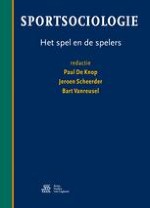Samenvatting
Vlaanderen en Nederland zijn altijd een beetje rivalen geweest in sport en topsport. In de jaren tachtig/negentig bruiste de publieke belangstelling als de Belgische nationale voetbalploeg uitkwam tegen Nederland. De laatste jaren is dit minder sterk geworden. De fiere Vlaamse leeuw weegt niet op tegen de Nederlandse trots. Een trots die er mag zijn in top-sport. De cijfers van de Olympische Spelen spreken boekdelen. In Athene behaalde Nederland 22 medailles, België drie. In Sydney is het verschil nog nooit zo groot geweest. Nederland behaalde twaalf gouden medailles en behoort hiermee tot de top tien van de wereld, terwijl België in Sydney terugzakt naar een 54e plaats. figuur 7-1 illustreert de prestatieverschillen tussen België en Nederland in de periode 1980-2004. De figuur geeft de prestaties weer tijdens de Olympische Spelen, wereldkampioenschap of Europees kampioenschap, gewogen met respectievelijk 6, 4 en 2 punten. De punten zijn weergegeven voor de behaalde eerste acht plaatsen – afhankelijk van de tak van sport – volgens twee systemen:
-
■ eerste 8 plaatsen: 10 – 8 – 6– 5 – 4 – 3 – 2 – 1 punten;
-
■ winnaar – finale – halve finale – kwartfinale: 10 – 8 – 5,5 – 2,5 punten (onder andere badminton, boksen, tafeltennis en tennis).
